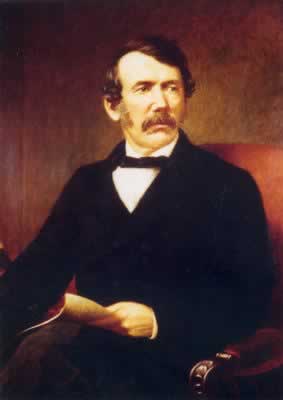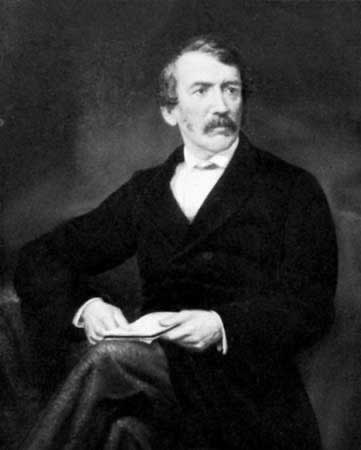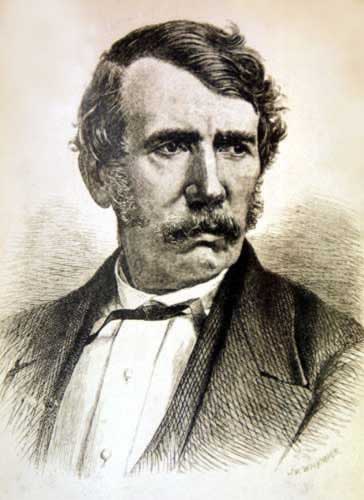Think that you may own a portrait of explorer David Livingstone? We authenticate, appraise and issue Certificates of authenticity (COA) for all portraits of David Livingstone.

David Livingstone from 1864 photo by Thomas Annan
David Livingstone was a Scottish Presbyterian pioneer medical missionary with the London Missionary Society and explorer in central Africa. He was the first European to see Victoria Falls, which he named in honor of the reigning monarch. He is the subject of the meeting with H. M. Stanley, which gave rise to the popular quotation, "Dr Livingstone, I presume?"
David Livingstone was born on March 19, 1813 in the village of Blantyre, Lanarkshire, Scotland, into a Christian family believed to be descended from the highland Livingstones, a clan that had been previously known as the Clan MacLea.

Livingstone Etching from Thomas Annan photo
David Livingstone's father Neil was very religious, a Sunday School teacher and teetotaller who handed out Christian tracts on his travels as a tea merchant, and who read books on theology, travel and missionary enterprises. This rubbed off on the young David, who became an avid reader, but he also loved scouring the countryside for animal, plant and geological specimens. Neil Livingstone had a fear of science books as undermining Christianity, but David instinctively felt that religion and science were friendly to each other. When he read Philosophy of a Future State by the science teacher and church minister Reverend Thomas Dick, he found the rationale he needed to combine the two, and apart from the Bible this book was perhaps his greatest philosophical influence.
The other great influences on his life were Thomas Burke, a Blantyre evangelist; David Hogg, his Sunday School teacher; the missionary Karl Gützlaff, whose "Appeal to the Churches of Britain and America on behalf of China" persuaded Livingstone to join the London Missionary Society (LMS); and Robert Moffat, a fellow Scot and missionary in southern Africa (and whose daughter Mary he was later to marry).
A further great influence, though, was not a person, but a job. From the age of ten he worked in a factory as a spinner to help support the family. The years of monotony gave him persistence, endurance, and a natural empathy with all who labor, as expressed by lines he used to hum from the egalitarian Robbie Burns song: "When man to man, the world o'er / Shall brothers be for a' that".
Livingstone first studied Latin, medicine, theology at the University of Glasgow. While there he read Gutzlaff's appeal and applied to join the LMS and was accepted subject to missionary training. He continued his medical studies in London while training there to be a minister under the eye of the LMS. Despite his impressive personality, he was a poor preacher and would have been rejected by the LMS had not the Director given him a second chance to pass the course.
Livingstone hoped to go to China as a missionary, but the Opium Wars flared up there and the LMS suggested the West Indies instead. But those islands already had access to the medical practices of the day, and Livingstone wanted to go where such skills were most needed. Robert Moffat told him that he was the right person to go to the vast plains to the north of Bechuanaland in Southern Africa, where he had glimpsed "the smoke of a thousand villages, where no missionary had ever been".
Livingstone arrived at Moffat's mission in Kuruman, now part of South Africa, in 1841. Setting up a new mission at Mabotswa, in 1844 he was mauled by a lion which might have killed him if it had not been distracted by his assistant, Mabelwa, who was also badly injured. Both recovered but Livingstone's arm was partially disabled thereafter.
After falling out with a colleague, in 1845 he moved to an out-station at Chonuane, finally Kolobeng in 1847. These missions in what is now Botswana suffered from drought but he was unable to make inroads east into wetter areas of the Transvaal of South Africa because of Boer opposition.
He married Mary Moffat in 1845, and she traveled with him for a brief time at his insistence, despite her pregnancy and the protests of the Moffats. She later returned to England with their children, but came to Africa again on the Zambezi Expedition.
After the Kolobeng mission had to be closed due to drought, he explored the African interior to the north, in the period 1852–56, and was the first European to see the Mosi-oa-Tunya ("the smoke that thunders") waterfall (which he renamed Victoria Falls after his monarch, Queen Victoria).
Livingstone was one of the first Westerners to make a transcontinental journey across Africa, Luanda on the Atlantic to Quelimane on the Indian Ocean near the mouth of the Zambezi, in 1854-56. Despite attempts especially by the Portuguese, the great peninsula of central and southern Africa had not been crossed by Europeans at that latitude owing to their susceptibility to malaria, dysentery and sleeping sickness which was prevalent in the interior and which also prevented use of draught animals (oxen and horses), as well as to the opposition of powerful chiefs and tribes, such as the Lozi, and the Lunda of Mwata Kazembe.
The qualities and approaches which gave Livingstone an advantage as an explorer were that he usually traveled light, and he had an ability to reassure chiefs that he was not a threat. Other expeditions had dozens of soldiers armed with rifles and scores of porters carrying supplies, and were seen as military incursions or were mistaken for slave-raiding parties. Livingstone on the other hand traveled on most of his journeys with a few servants and porters, bartering for supplies along the way, with a couple of guns for protection. He preached a Christian message but did not force it on unwilling ears; he understood the ways of local chiefs and successfully negotiated passage through their territory, and was often hospitably received and aided, even by Mwata Kazembe.
Livingstone was a proponent of trade and Christian missions to be established in central Africa. His motto, inscribed in the base of the statue to him at Victoria Falls, was "Christianity, Commerce and Civilisation." At this time he believed the key to achieving these goals was the navigation of the Zambezi River as a Christian commercial highway into the interior. He returned to Britain to try to garner support for his ideas, and to publish a book on his travels which brought him fame as one of the leading explorers of the age.
Believing he had a spiritual calling for exploration rather than mission work, and encouraged by the response in Britain to his discoveries and support for future expeditions, in 1857 he resigned from the London Missionary Society.
The British government agreed to fund Livingstone's idea and he returned to Africa as head of the Zambezi Expedition to examine the natural resources of southeastern Africa and open up the River Zambezi. Unfortunately it turned out to be completely unnavigable past the Cabora Bassa rapids, a series of cataracts and rapids that Livingstone had failed to explore on his earlier travels.
The expedition lasted from March 1858 until the middle of 1864. Livingstone was an inexperienced leader and had trouble managing a large-scale project. The artist Thomas Baines was dismissed from the expedition on charges (which he vigorously denied) of theft. Livingstone's wife Mary died on 29 April 1863 of malaria, but Livingstone continued to explore, eventually returning home in 1864 after the government ordered the recall of the Expedition. The Zambezi Expedition was castigated as a failure in many newspapers of the time, and Livingstone experienced great difficulty in raising funds further to explore Africa. Nevertheless, the scientists appointed to work under Livingstone, John Kirk, Charles Meller, and Richard Thornton did contribute large collections of botanic, ecological, geological and ethnographic material to scientific institutions in the UK.
In March 1866, Livingstone returned to Africa, this time to Zanzibar (which is currently part of Tanzania), where he set out to seek the source of the Nile. Richard Francis Burton, John Hanning Speke and Samuel Baker had (although there was still serious debate on the matter) identified either Lake Albert or Lake Victoria as the source (which was partially correct, as the Nile "bubbles from the ground high in the mountains of Burundi halfway between Lake Tanganyika and Lake Victoria"). Finding the Lualaba River, Livingstone decided it was the "real" Nile, but in fact it is the Upper Congo River.
Although Livingstone was wrong about the Nile, he discovered for western science numerous geographical features, such Lake Ngami, Lake Malawi, and Lake Bangweulu in addition to Victoria Falls mentioned above. He filled in details of Lake Tanganyika, Lake Mweru and the course of many rivers, especially the upper Zambezi, and his observations enabled large regions to be mapped which previously had been blank. Even so, the furthest north he reached, the north end of Lake Tanganyika, was still south of the Equator and he did not penetrate the rainforest of the River Congo any further downstream than Ntangwe near Misisi.

Etching, Unknown Artist
Livingstone was awarded the gold medal of the Royal Geographical Society of London and was made a fellow of the society, with which he had a strong association for the rest of his life.
“And if my disclosures regarding the terrible Ujijian slavery should lead to the suppression of the East Coast slave trade, I shall regard that as a greater matter by far than the discovery of all the Nile sources together” — Livingstone in a letter to the editor of the New York Herald.
Livingstone's letters, books and journals did stir up public support for the abolition of slavery. However he became humiliatingly dependent for assistance on the very slave-traders whom he wanted to put out of business. Because he was a poor leader of his peers, he ended up on his last expedition as an individualist explorer with servants and porters but no expert support around him. At the same time he did not use the brutal methods of maverick explorers such as Stanley to keep his retinue of porters in line and his supplies secure. For these reasons from 1867 onwards he accepted help and hospitality from Mohamad Bogharib and Mohamad bin Saleh (also known as Mpamari), traders who kept and traded in slaves, as he recounts in his journals. They in turn benefited from Livingstone's influence with local people, which facilitated Mpamari's release from bondage to Mwata Kazembe.
Livingstone was also furious to discover some of the replacement porters sent at his request from Ujiji were slaves. Livingstone completely lost contact with the outside world for six years and was ill for most of the last four years of his life. Only one of his 44 letter dispatches made it to Zanzibar. Henry Morton Stanley, who had been sent in a publicity stunt to find him by the New York Herald newspaper in 1869, found Livingstone in the town of Ujiji on the shores of Lake Tanganyika on November 10, 1871, greeting him with the now famous words "Dr Livingstone, I presume?"
Some in Burundi claim the famous meeting took place 12 km south of Bujumbura at the spot marked by the Livingstone-Stanley Memorial, Mugere, but that marks a visit they made 15 days after their first meeting - see linked article for references - on their joint exploration of the north end of Lake Tanganyika, which ended when Stanley left in March the next year.
Despite Stanley's urgings, Livingstone was determined not to leave Africa until his mission was complete. His illness made him confused and he had judgment difficulties at the end of his life. He explored the Lualaba and failing to find connections to the Nile, returned to Lake Bangweulu and its swamps to explore possible rivers flowing out northwards.
He died in that area in Chief Chitambo's village at Ilala southeast of Lake Bangweulu in Zambia, on 4 May 1873 from malaria and internal bleeding caused by dysentery. (His journal indicates that the date of his death would have been 1 May, but his attendants noted the date as 4 May, which they carved on a tree and later reported; this is the date on his grave.) Livingstone's heart was buried under a Mvula tree near the spot where he died, now the site of the Livingstone Memorial. His body together with his journal was carried over a thousand miles by his loyal attendants Chuma and Susi, and was returned to Britain for burial in Westminster Abbey.
By the late 1860s Livingstone's reputation in Europe had suffered owing to the failure of the missions he set up, and of the Zambezi Expedition; and his ideas about the source of the Nile were not supported. His expeditions were not models of order and organization.
His reputation was rehabilitated by Stanley and his newspaper, and by the loyalty of Livingstone's servants whose long journey with his body inspired wonder. The publication of his last journal revealed stubborn determination in the face of suffering.
He had made geographical discoveries for European knowledge. He inspired abolitionists of the slave trade, explorers and missionaries. He opened up Central Africa to missionaries who initiated the education and health care for Africans, and trade by the African Lakes Company. He was held in some esteem by many African chiefs and local people and his name facilitated relations between them and the British.
Partly as a result, within fifty years of his death, colonial rule was established in Africa and white settlement was encouraged to extend further into the interior.
On the other hand, within a further fifty years after that, two other aspects of his legacy paradoxically helped end the colonial era in Africa without excessive bloodshed. Livingstone was part of an evangelical and nonconformist movement in Britain which during the 19th century changed the national mindset from the notion of a divine right to rule ‘lesser races', to ethical ideas in foreign policy which, with other factors, contributed to the end the British Empire. Secondly, Africans educated in mission schools founded by people inspired by Livingstone were at the forefront of national independence movements in central, eastern and southern Africa.
While Livingstone had a great impact on British Imperialism, he did so at a tremendous cost to his family. In his absences, his children grew up fatherless, and his wife Mary (daughter of Mary and Robert Moffat) eventually died of malaria trying to follow him in Africa. His one regret in later life was that he did not spend enough time with his children.
Still wondering about a portrait in your family collection? Contact us... it could be a portrait of David Livingstone.
